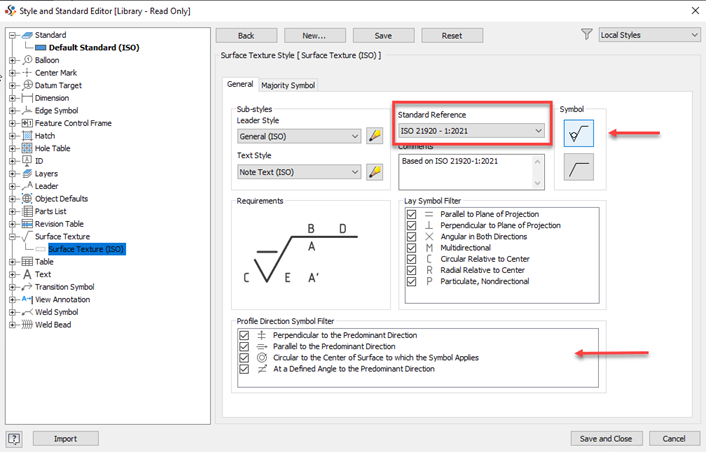Overview
This release contains a multitude of enhancements to help you solve your everyday design challenges.

Inventor 2025 delivers:
Performance
For the past eight years, performance continues to be a top priority to improve your time to market. The original performance tool, "Patterns," has been improved to establish advanced boundary controls within sketch and feature patterns. The application of real-world design intent through the Finish feature is now faster than ever, thanks to new selection options and enhanced support for downstream derivation.
Modern Look and Usability
The modernization of Inventor extends beyond mere aesthetic improvements to increase product development agility. This year, we've taken great care in streamlining and enhancing three key sheet metal commands: Sheet Metal Flange, Face, and Cut. These commands have been significantly improved with interactive in-canvas previews and manipulators, a configurable property panel interface, and new visual references for determining termination directions. We've also refined sketch line rendering and improved the highlighting of component face and edge selections.
Interoperability
Another key focus of this release is to provide dependable data interoperability and collaboration tools for those working with Architectural, Engineering, and Construction (AEC) data. This release allows you to effortlessly save designs to earlier versions of Autodesk Revit, accommodating those who are using older releases, going as far back as 2023. Our improved IFC import interface enables you to import only the necessary geometry and metadata for a specific project. This interface now includes graphical previews, class inclusion/exclusion options, and a new AEC property viewer.
Standards Adherence
We continue to update both 2D and 3D documentation capabilities to improve collaboration with manufacturing. You can now create and annotate precise hole representations in accordance with the latest global standards. Bulk promoting selected sketch or feature dimensions into 3D annotations is now possible. Additional features include updated 2D surface texture symbols, a new arc dimension symbol for the ISO standard, presets within 3D general profile notes and 2D sheet text, new transition annotations, and the ability to configure new break marks on cropped view edges.
Performance
Feature Patterns
In the Part modeling environment, you can now use a face, multiple faces of the same planar feature, or a sketched boundary to pattern features only within that boundary. You select the method that is used for the pattern, such as only features within the boundary, all features with centroids inside the boundary, or by using a base point where all features with the base point inside the boundary are used.

For more information about feature patterns, see About Part Feature Patterns and To Arrange Part Features in Patterns.
Sketch Pattern Enhancements
You can now use a sketched boundary and pattern sketch geometry only within that boundary. You determine which geometry is used in the pattern, such as only within the boundary, all with centroids inside the boundary, or by using a base point where all geometry with base points inside the boundary are used.

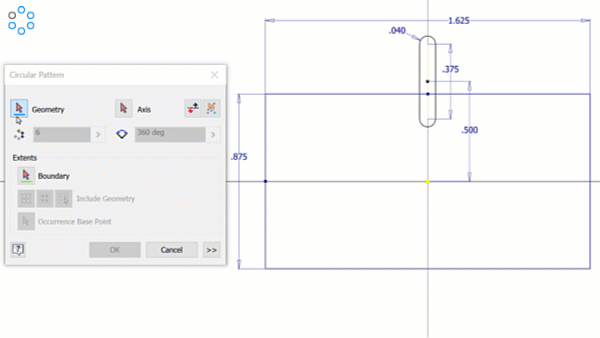
For more information about sketch patterns, see To Create and Edit Sketch Patterns.
Finish Feature
Finish Feature Selectors
The existing Finish feature selector was replaced by two selectors: "Include" and "Exclude".
Use the Include selector for selection of faces and bodies (un-select when in combination with the 'Ctrl' button).
Use the Exclude selector to select faces that should be excluded from selection.
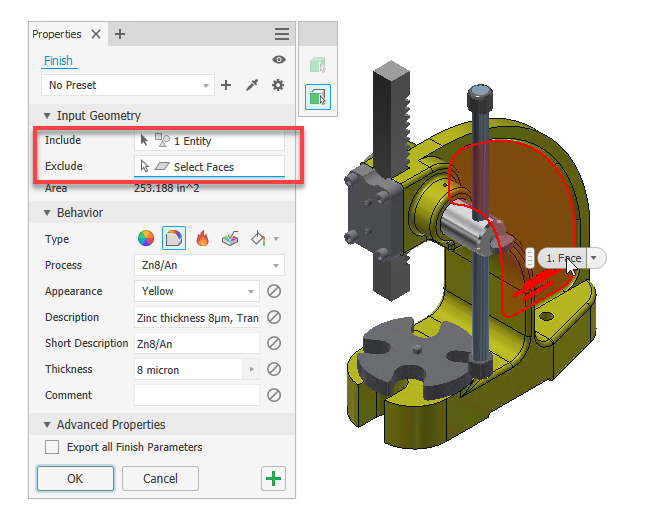
For more information see To Assign a Finish to a Component.
Body or Face Selections Priority
Utilize the new selection option to specify whether to select solid or surface bodies on the part, or only faces. When the body selection filter is active, you can select a body and make further adjustments by removing faces from the selected body using the face selection filter. Hold the "Ctrl" button to select multiple faces at once.

Derive Part
In Parts, Appearances, Finishes, and Finish Parameters can now be derived to the target document when using the Derive command, as well as the Make Part command. When including a Finish, all its parameters will be automatically included. Conversely, when excluding a Finish, all its parameters will be automatically excluded. Note that suppressed finishes cannot be derived.
In the "Derived Part" dialog, all finish features of the derived part are located within the "Finishes" folder. Finishes on excluded or 'Bounding-boxed' solids are not eligible for inclusion. Similarly, finishes suppressed in the source part cannot be included. Finishes applied to multiple solids will only be displayed on included solids and will not appear on the faces of excluded or 'Bounding-boxed' solids
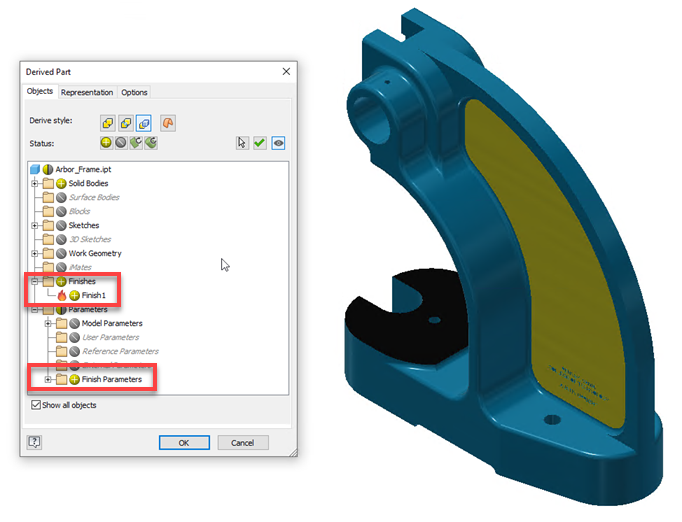
Finish parameters are located within the 'Parameters > Finish Parameters folder.
When a Finish feature is included, its parameters are also included but can be manually excluded. However, Finish parameters cannot be included if the Finish itself is excluded.
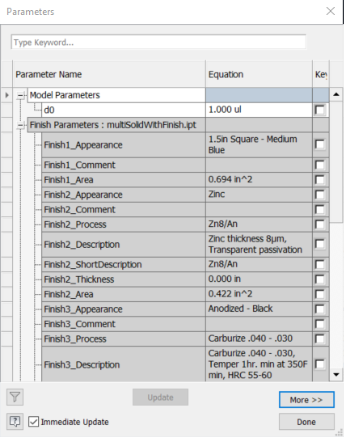
If there is at least one derived Finish feature, a new "Finishes" folder will be displayed under the Derived Part browser node. Derived Finishes cannot be repositioned, and they are ordered the same way as in the source part.
Derived Finish features cannot be modified.
Generated iPart members incorporate all Finish features in accordance with the member table.
For more information see Create a Simplified Part from an Assembly, To Create a Derived Part or Assembly, and Make Part Reference.
Make Part, Make Component
The "Make Part" and "Make Component" commands now support the use of Finish features.
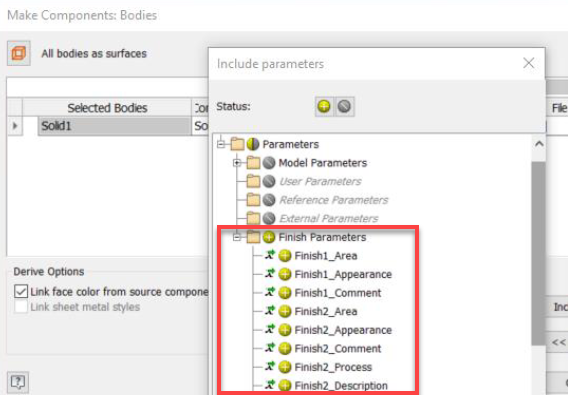
Disable Parameters
You can now disable or delete a desired Finish parameter. To disable a parameter, select the "Disable parameter" button next to it. When the parameter is disabled, corresponding entries will not be created in the Parameters table. Any existing parameters associated with the disabled field will be removed from both the Parameters table and the iComponent table.
Some finish features do not require an appearance override. You can use the "Disable parameter" button to control the application of appearance overrides.
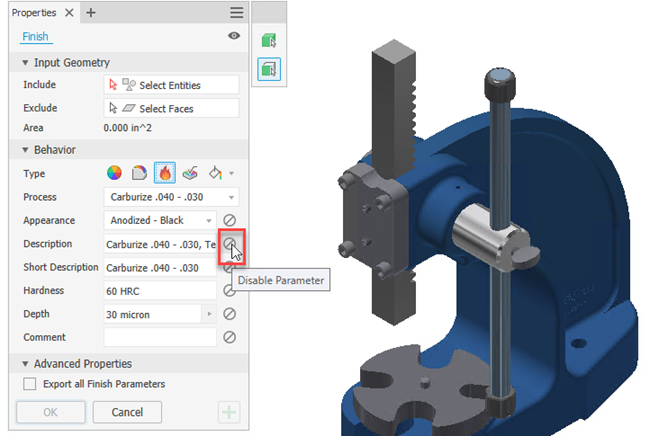
Show Extended Names
Use the Show Extended Names option in the browser Display Preferences drop-down menu to display extended information after the feature node name for the following Finish types:
Appearance: Color
Material Coating: Process
Heat Treatment: Process
Surface Texture: Process
Painting: Process
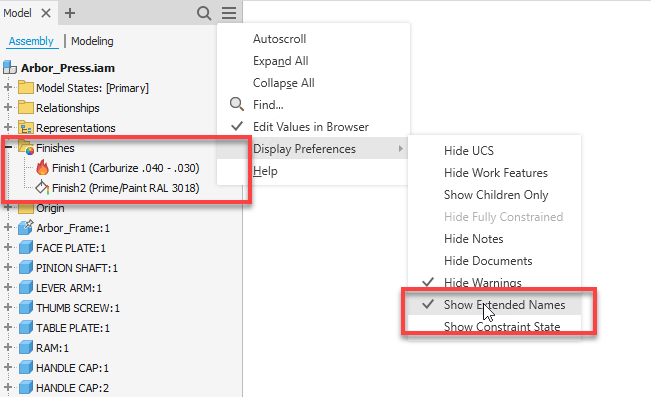
Quick access to XML folder location*
The new "Open Finish Library Location" item in the panel menu provides quick access to the folder where the Finish XML definitions are located.
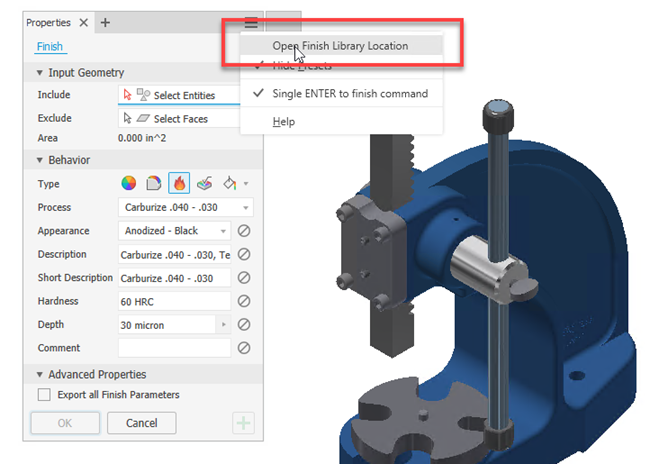
Other Finish Improvements*
All parameters that are not defined in the XML definition file will no longer be displayed in the Property Panel, and such parameters will not be created.
In assemblies, any finish applied to a component that is to be mirrored is now also included.
The hardness input has been changed to a text field, allowing input of any kind of units and ranges of hardness values.
The Finish feature utilizes an internal name to match appearances between localized versions, enabling you to seamlessly move documents between different localized versions.
You can now delete and re-order Finishes in Express mode.
Presentation Enhancement

You can now replace the source model in a Presentation. The process is similar to drawing replace model reference. To change model states of the reference model use the same workflow and the file Open options to select the desired model state.
For more about Presentations see About Presentations, Exploded Views, and Publishing and To Create Presentation for a Model.
Simplify Command Enhancements
Starting with this release, components can be replaced with a simple cylinder.
To do this, select any of the "Replace" options in the "Replace with Envelopes" area and set the type to "Oriented Minimum Bounding Cylinder". When the 'All In One Envelope' type option is selected, the Diameter and Height values are displayed both in the panel and on the canvas.

For more information, see Create a Simplified Part from an Assembly.
Oriented Bounding Cylinder
Starting with this release, a selected component in the derived part and assembly can be represented as a bounding cylinder. This reduced-detail option decreases memory consumption. The bounding cylinder will update to reflect any changes in the derived or base component. Additionally, you have the flexibility to mix bounding boxes and bounding cylinders. This means one body can be simplified as a box, while another can be represented as a cylinder.

For more information see To Create a Derived Part or Assembly, Make Part Reference.
Hole Enhancements
In both, parts and assemblies you can now use 3 new drill point types (Flat W, Angle V, Angle Y) when creating holes. The Angle Y type creates a drill point that is that is incorporated into the hole depth parameter. The Flat W type results in the creation of a flat drill point.

The "Drill Point Type" button, which adds the <DPOINT> tag to 2D and 3D Hole Note annotations, was added to the Hole Note dialog. By using this tag, the active Drill Point Type is included in the annotation, represented by the following symbols:
Flat = "U"
Angle = " " (nothing is added for this Drill Point Type)
Flat W = "W"
Angle V = "V"

Additionally, the "Thread Direction" button was added to the "Hole Note" dialog, enabling the addition of the <TDIR> tag for thread direction. By checking the "Right Handed Thread" box, "RH" will be displayed for Right Handed Threads in annotations.
The formatting is managed using the Styles Editor.
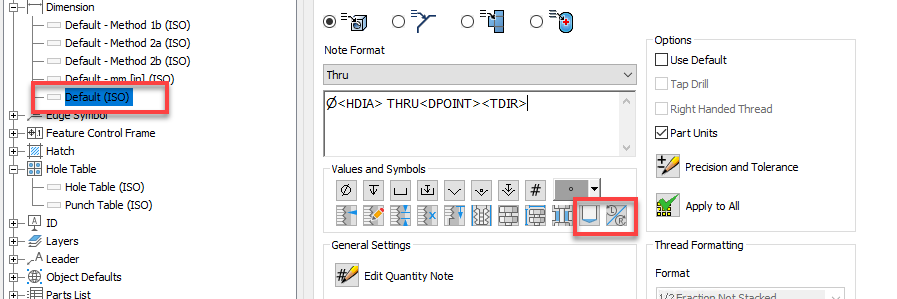
For more information see To Create Holes, Edit Hole Note Reference, Style and Standard Editor – Dimension Reference.
Promote Dimensions
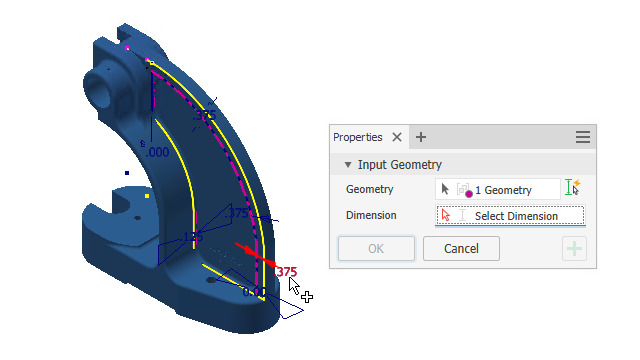
In both parts and assemblies, you now have the ability to create 3D annotation dimensions directly from the dimensions of the selected sketch or feature using the newly added "Promote Dimensions" command within the Annotate tab.
Select a feature or a sketch to enable the dimensions, and then select the dimensions you want to promote.
For more information see To Promote Dimensions.
Bolted Connection Enhancement
When using the Bolted Connection Generator, you can now select patterns (circular and rectangular) created in an assembly environment. The "Follow Pattern" option is added to the "Placement" area of the Design tab.

For more information see To Create and Insert Bolted Connections.
3D Weld Symbol
Weld symbols in 3D can now be created with ease by selecting fillet weld features.
Select either a face or an edge of the weld feature, then select "Sync Preset" from the context menu to sync the data from legacy 3d weld symbol. The Sync Preset functionality is available only for a 3D weld symbol that is attached to a weld bead feature.
The "Sync Preset" loads the following parameters:
Leg 1
Leg 2
Length
Pitch
Countour
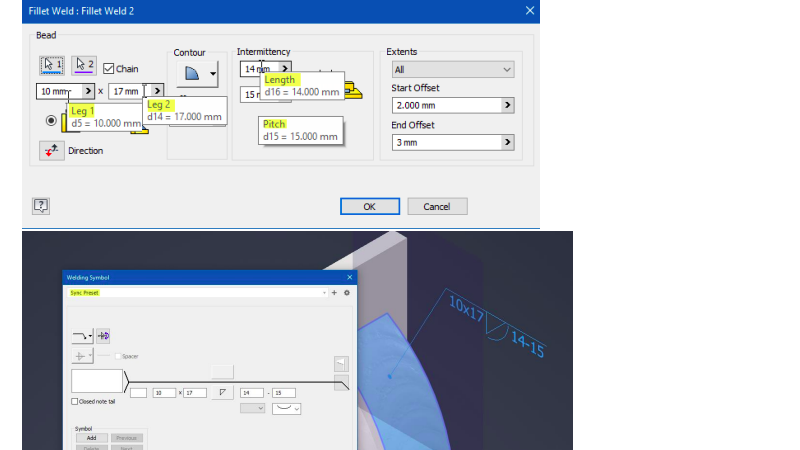
Ability to Scale Revision Cloud Arcs
Several enhancements have been made when working with revision clouds. Now, you can change the size of the revision cloud arcs, allowing the creation of revision clouds around smaller details in the view.
You can also edit the revision cloud using the context menu of the revision cloud browser node using the newly added "Edit..." command. In the "Revision Cloud" dialog, you can select an option to display the dialog box each time you insert a new revision cloud. This allows you to edit it immediately and use the current settings as the default values.

For more information see To Work with Revision Clouds.
Add the Sort Parts List Option
You are now able to specify the sort order of items in the Bill of Materials (BOM) for parts lists directly in the Styles Editor using the newly added "Sort" option.
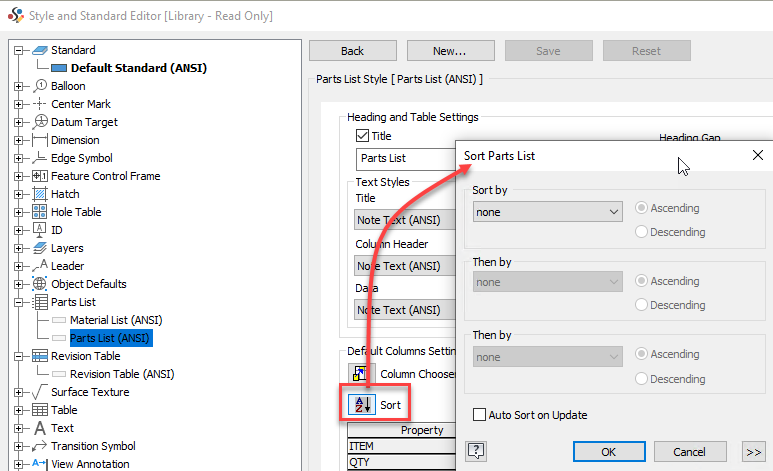
For more information see Style and Standard Editor - Parts List Style Reference.
Revision Index Settings for Revision Tables
It is now possible to specify default numbering (alpha or numeric) from within a drawing template instead of via the revision table itself. A new "Revision Index Defaults" option has been added to the "Style and Standard Editor" for Revision Tables.
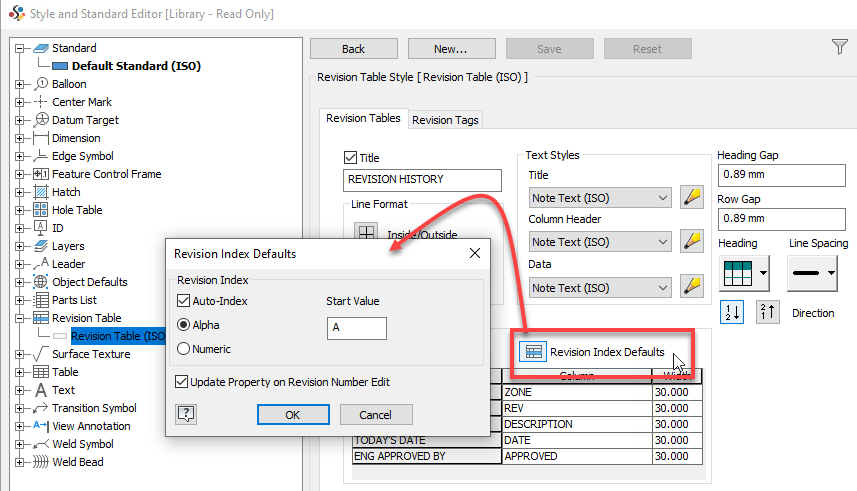
For more information see Style and Standard Editor - Revision Table Style Reference, Revision Table Reference.
Modern Look and Usability
Sheet Metal
The following Sheet Metal commands have been modernized, incorporating the property panel interface and workflows. Quickly and easily create sheet metal flange, face, and cut features. Take advantage of the updated interface and workflows to improve your sheet metal tasks.
Property panel workflows
Everything in one panel, no tabs
Supports Light and Dark themes
For general information about property panel use, options, and menus, see About Property Panels
Includes Preset capabilities, see To Work with Presets
Face*
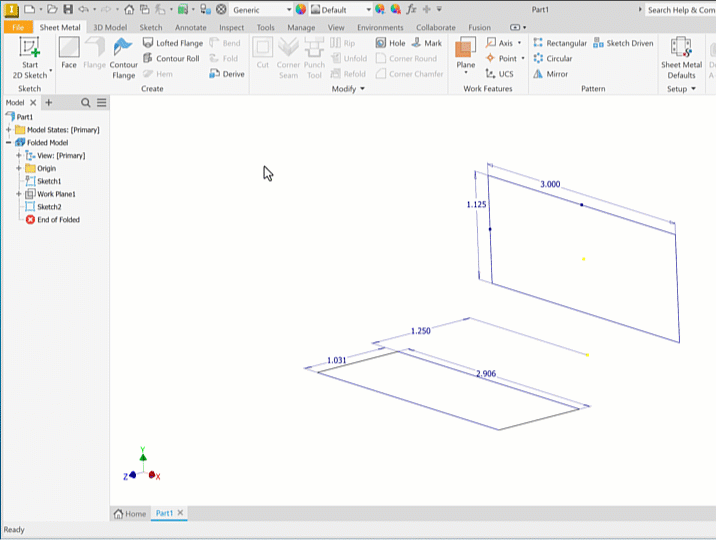
For more information see To Work with Faces in Sheet Metal.
Flange*
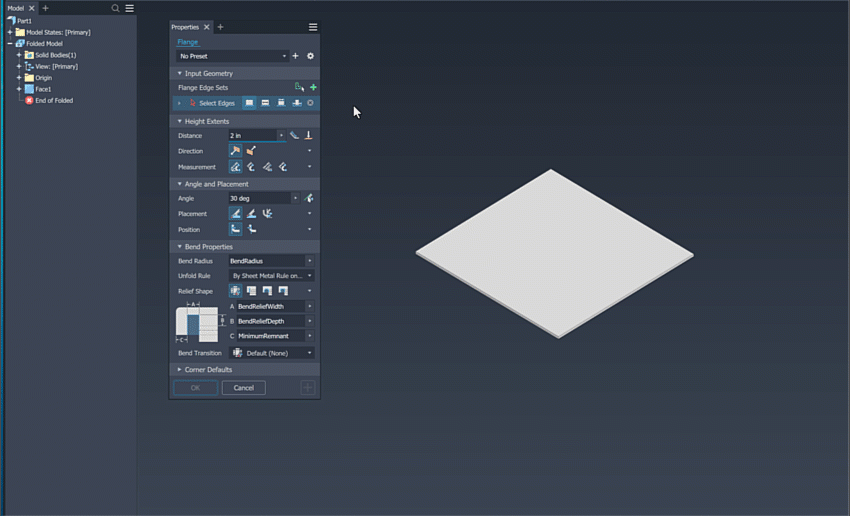
For more information see To Work with Flanges in Sheet Metal.
Cut*

For more information see To Work with Cuts on Sheet Metal.
Other Sheet Metal Improvements*
Cut
Region selection has been improved for the Cut command.
Export Flat Pattern as DXF
A new layer, IV_UNCONSUMED_SKETCH_CONSTRUCTION, is added to the DXF export options. All exported construction geometry is placed on that layer. If the layer is turned off, no construction geometry is exported.
Interoperability
Revit Interoperability
Output to Select Revit Versions
You now have the ability to export to Revit 2023 and newer versions. If the matching Revit Core Engine (RCE) isn't installed you are prompted to install it. As the installation proceeds you can work in Inventor doing other tasks. When the install is complete, restart the command you used before the installation.
The Revit versions feature is added for the following commands:
Simplify

When using the Simplify command to export Revit (*.RVT) flies, select the version from the drop down list.
For more information see To Export a Model to RVT (Revit format).
Export Building Components
When using the BIM Content Environment to output RFA files, click the Options button to access the Revit versions list.

For more information see To Export Building Components.
RFA File Output Fidelity
Inventor now provides greater graphical fidelity for models exported to RFA format.
For more information see To Export Building Components.
Industry Foundation Class (IFC) Import for Inventor
Inventor now has IFC import capability. You make import choices that affect performance, which data is imported, and IFC properties and parameters.
The import dialog provides the option to load the model enabling you to control which content is imported and how it is represented in the modeling environment. Selections highlight in both the Import panel and in the canvas. You can exclude entire IFC classes or individual elements.

Standards Adherence
Transition Symbol
Starting from this release of Inventor, you can define the Transition Symbol based on the ISO 21204:2020 standard. The new Transition Symbol command has been added to the Symbols panel of the Annotate tab.
There are three types of transition symbols based on their placement.
Edge: This type of transition symbol is created by selecting certain geometry from the view or sketch during the creation process. It can also be reattached.
Face: Created when it is generated in an empty space within the view bounding box.
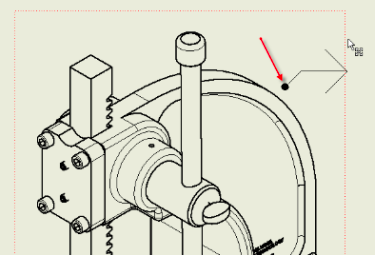
Sheet: Created when it is generated in the empty space of a sheet.
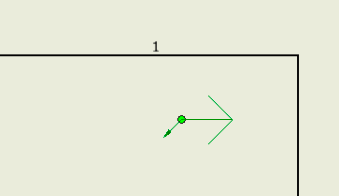
Use the Style and Standard Editor to adjust the style of the transition symbol.
For more information see Add a transition symbol and Style and Standard Editor - Transition Symbol Style Reference.
Arc Symbol for Dimensions
You can now create dimensions with the arc symbol according to the ISO 129-1:2018 standard.
New options have been added to the "Options" tab of the "Style and Standard Editor" to specify the position of the arc symbol (either above or before the dimension).

For more information see Style and Standard Editor – Dimension Reference.
3D Annotation and Model-Based-Definition
You can use presets in General Note and General Profile Note commands located in the General Annotation panel.
Preset can contain:
Text
Symbols
Parameters
Standard iProperties
Physical Properties
Presets for General Note and for General Profile Notes are not shared, separate presets need to be created for each. However, presets for General Notes are shared between both parts and assemblies.

For more information see To Work with Text and Leaders.
Automatic Break Lines in Crop Views
New options have been added to the "Style and Standard Editor" to set break lines at the edges of the cropped view. In the "Style and Standard Editor", expand the "View Annotations" item and select "Crop" to specify the style.

For more information see Style and Standard Editor - View Annotation Style Reference.
Surface Texture
You now can define Surface Texture Symbols based on the ISO 21920-1 standard.
